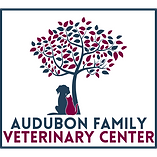Obesity in Pets: Understanding the Risks and Prevention
- Audubon Family Vets

- Oct 16, 2023
- 3 min read

Obesity in pets has become a significant issue in recent years, with a growing number of domestic animals being classified as overweight or obese. This condition can lead to a multitude of health problems, including diabetes, arthritis, and heart disease. Cats generally only need 180-225 calories per day and many cats are grossly overfed. Their energy requirements may be lower if they are spayed or neutered, which could lead to overfeeding. In this blog, we explore the risks associated with pet obesity and how to prevent it.
What Causes Pet Obesity?
The primary cause of pet obesity is an imbalance between energy intake and expenditure. If pets consume more calories than they expend through physical activity, their bodies will store the excess energy as fat. While some breeds may be more susceptible to weight gain, the primary contributing factor is an inappropriate diet and lack of exercise.
Health Risks of Pet Obesity Obesity in pets can lead to a range of health issues that can significantly impact their quality of life. Common health risks associated with pet obesity include:
Diabetes: Obese pets are more likely to develop diabetes, which can lead to insulin resistance, high blood sugar levels, and other serious health complications.
Joint problems: Excess weight puts a strain on joints, which can lead to arthritis and other joint-related conditions. Signs of arthritis can be seen on x-ray as early as 5 years old in dogs and cats, which is worsened by obesity. Keeping your pet lean is essential to their joint health.
Heart disease: Obesity is a significant risk factor for heart disease in pets. It can lead to high blood pressure, heart failure, and other cardiovascular issues.
Respiratory problems: Obese pets may struggle to breathe, which can cause respiratory issues.
Preventing Pet Obesity The good news is that pet obesity is preventable. Here are some tips to help keep your pet healthy and fit:
Feed a balanced diet: Ensure that your pet is on a well-balanced diet that meets their nutritional needs. Avoid overfeeding or feeding high-calorie treats. This starts at your puppy and kitten visits. Talk with your vet about the nutrient needs of your pet at their first visit. This will change throughout the first year or two of life. Once your pet reaches adult weight (at around a year for most animals except giant breed dogs), they should be switched to adult food. Pet food is age-specific. For example, adult food contains less calories than puppy or kitten food. If you notice that your pet is gaining weight, contact your vet immediately for an in-depth nutritional evaluation and assessment.
Exercise: Regular exercise is crucial to maintaining a healthy weight. Take your pet for daily walks or runs, or engage in other physical activities that they enjoy.
Portion control: Avoid overfeeding your pet; measure their food portions and avoid free-feeding. Free-feeding (except in specific instances concerning cats - please discuss this with your vet).
Regular check-ups: Regular vet visits are essential to monitor your pet's weight and health.
Obesity in pets is a preventable health concern that can lead to severe health complications if left untreated. By providing a balanced diet, regular exercise, and portion control, you can help your pet maintain a healthy weight and live a long, healthy life.
Contact your veterinarian if you have any questions or concerns about weight or body condition.






Comments